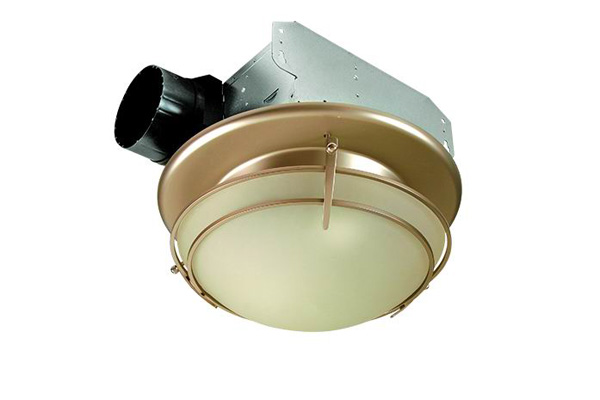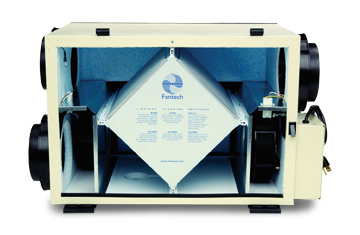ABOUT VENTILATION
Delivering the right amount of fresh air
All the effort that goes into creating tighter houses results in significant energy savings and greater comfort. But moisture, chemical toxins, and cooking odors can’t dissipate as easily in a house with a tight envelope as in a leaky house. Opening a few windows may provide too much or too little ventilation, with adverse effects on comfort in either case. Even in houses where building materials and furnishings have been carefully chosen to reduce indoor air pollutants, some form of mechanical ventilation is a prerequisite for healthy occupants and a healthy building.
There are two basic strategies to provide mechanical ventilation: spot ventilation, which removes moisture and pollutants at their source, and whole-house ventilation.
Typical spot ventilation strategies include the use of bathroom exhaust fans and an exhaust fan over the kitchen range. Exhaust fans are available in a variety of sizes, styles and price ranges. Control options range from simple wall switches to sophisticated timers, occupancy sensors, or humidistats.
Whole-house mechanical ventilation systems are designed to remove stale air from or supply fresh air to the building as a whole. These systems are more complicated and more expensive than spot ventilation systems, but also more effective.
Use a variable speed furnace fan
Some ventilation systems use the furnace fan to distribute air around the house. In these systems, the fan speed used for heating and cooling is probably too high in a ventilation-only mode. A variable-speed or two-speed fan is more efficient, using less power for ventilation than for heating and cooling.

This article is only available to GBA Prime Members
Sign up for a free trial and get instant access to this article as well as GBA’s complete library of premium articles and construction details.
Start Free TrialAlready a member? Log in












7 Comments
Insulating old house: When is a ventilation system required?
I'm curious to know at which 'air tightness' level a balanced ventilation system is recommended or required. We bought an old drafty fixer-upper two years ago and on windy days you could feel the air move through the house. Heating bills were $600 and above for some NH winter months. In the meantime we spray-foamed the whole attic, about half the outside walls (we're renovating through the house room by room), and replaced most windows with new, tight HE windows.
A recent blower door test still came back with values of more than 4000 at a 50psi pressure difference (I forget the unit), which from what I know is still a value as if there is a window open. During the test we indeed found a number of so far unknown air leaks in the basement and an addition that we have not touched yet, so right now we still have plenty of air exchanges on their own (even though the highest heating bill this winter was less than $250, I guess previously we had 4 open windows :-)
So long story short, as we continue renovating, insulating and sealing off the house, at some point in time it might be so tight that we require a balanced air exchanger. Is there a criteria that can be determined with a blower door test (e.g. dropping below a certain value)? Any other criteria? Depending on how low the value is (or how high the tightness), would it be acceptable to e.g. only provide air in the central hallway on each floor, or would we have to provide air to each room (particularly the bed rooms, everything else is pretty much an open concept)?
Just FYI, even though we have not really planned for such a system yet, we e.g. replaced the old monster of a boiler from the 70s with a HE boiler that has a sealed combustion. The water heater will at some point in time be replaced by an indirect tank heated by the boiler. So replacement air for combustion inside the house will not be an issue.
Thanks, Christoph
Rule of thumb
Christoph,
You may want to read this article on blower door testing:
https://www.greenbuildingadvisor.com/blogs/dept/musings/blower-door-basics
The article includes the following rule of thumb: "If air-sealing work continues until the house is tightened below 1,000 cfm50, it’s advisable to install a whole-house mechanical ventilation system."
Fourth choice
I am building an ICF house with SIP roof. The blower test was 0.86 at 50 pascals. (Yes -86). The house has a "solar chimney" and no fan for a planned .3 changes/hr. The heat is hydronic through out. Can you point me in the direction for articles on this type of ventilation? Thank you for being such a great source of green technology. Mike Legge
Response to Mike Legge
Mike Legge,
No, I can't point you to a source of information on a house that will be ventilated using the stack effect. I don't recommend such a system.
You wrote, "The house has a solar chimney and no fan for a planned .3 changes/hr." Although you may be planning on 0.3 air changes per hour, the air in your house hasn't necessarily signed on to the program. In fact, the infiltration and exfiltration through your no-fan solar-chimney system will vary widely. Actual air exchange rates will depend on whether the sun is shining, the outdoor temperature, and the wind speed.
The only way to get a dependable ventilation rate is to install a fan and commission the ventilation system properly.
Fourth way of ventilating
Martin-thank you for your opinion. I have committed to natural ventilation and now feel nervous about my decision. I will e-mail you with all the design features and if it does or does not work . I have arranged for wiring to possibly accommodate a mechanical fan if your prediction proves correct.
http://www.cobaltengineering.com/vandusen.html
http://www.cobaltengineering.com/hamiltonfirehall.html
http://www.cobaltengineering.com/eskimos.html
These websites which are advertising ,do however state that they use natural ventilation so there may be a fourth way. Thank you for the helpful information that I have used in designing my house.Cheers Mike
Natural ventilation - when it's available
Mike,
In a lot of the case studies we've featured on GBA, the houses have been built to allow some natural ventilation when it's available, but that's not to say that they've relied exclusively on natural ventilation. In fact, i wonder how many of the places that claim to be designed this way actually function as they say. I didn't see any mention of exclusive natural ventilation on the sites you linked to; it might just be that they allow natural ventilation, unlike many modern commercial buildings which are intentionally designed without operable windows. Just be careful to get all of the facts when you see statements about topics like this.
“[Deleted]”
Log in or become a member to post a comment.
Sign up Log in